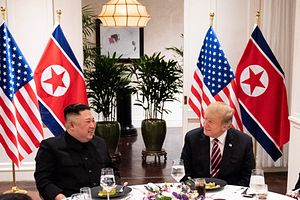The impasse that ended the Hanoi summit begs the question: What next? How can President Donald Trump and Chairman Kim Jong Un rekindle what might be called the “spirit of Singapore” and go on to reach accords useful to each side? North Korea continues to demand a graduated approach — “word for word, action for action.” Washington hints that it might accept a comprehensive approach implemented “in phases,” but it still leans toward all-or-nothing: Total North Korean nuclear disarmament in exchange for an end to all sanctions. The North, however, is reluctant to weaken its main bargaining asset — its small but still growing nuclear arsenal.
Is there a way to bridge these two approaches? We might find clues in America’s past dealings with the Kremlin and Beijing.
Worried by the mercurial Soviet leader, Nikita Khrushchev, many in the West wondered: Must we choose between being “Red or dead?” The president of the American Psychological Association, Charles E. Osgood, proposed a way to avoid these extreme choices. His book, An Alternative to War or Surrender (University of Illinois Press, 1962) outlined a strategy of graduated and reciprocal initiatives in tension-reduction: GRIT.
Osgood suggested that the stronger party take the first step. The initiator should announce its plan to move gradually toward better relations, making clear that its concessions did not arise from weakness but from an aim to shift from confrontation to cooperation. To minimize risk of abuse, the initial moves would be limited and reversible. The GRIT process would begin with small steps. If the other side reciprocated, larger moves would follow.
Is GRIT naïve and infeasible? No. This was essentially the path taken by John F. Kennedy and Khrushchev to arms control in 1963; by the Nixon-Kissinger duo as they opened a dialogue with Zhou Enlai and Mao Zedong in 1971-1972; and by Mikhail Gorbachev as he engaged with Ronald Reagan in the late 1980s. Of course, fake GRIT is also possible. Leaders of North and South Korea smiled, drank, and talked in secret for a year and then on July 4, 1972 openly committed their countries to unification by peaceful means. Soon, however, arrogant self-confidence in both Seoul and Pyongyang coupled with residual hostility spiked into zero-sum struggle. In 1974 the North tried to assassinate the South’s president, but killed his wife instead.
How does all this relate to U.S. negotiations with Pyongyang in 2019? Secretary of State Mike Pompeo has said of North Korean denuclearization that “we’re not going to do this in small increments” that would pressure the world “into relieving economic pressure.” National Security Assistant John Bolton has opposed any benefits for the North prior to its complete, verifiable, and irreversible denuclearization. Less rigid than Bolton, the U.S. president has proclaimed his desire to improve ties with Kim Jong Un and his country, but promises sanctions relief and investment only after denuclearization.
Withal, we now have a fragile double freeze. Kim Jong Un has pledged no more nuclear or missile tests for now, while Washington has halted its large-scale military exercises with South Korea. Some critics say that a double freeze means nothing, but if the North resumes missile testing, it may prove an ability to deliver a nuclear warhead and make it explode over California. This would be a game changer that could push Trump to attack the North’s launch pads, a scenario that could quickly lead to escalation across Northeast Asia and even to war between China and the United States.
Instead of security issues, the parties should first focus on reducing the distrust that feeds insecurity. Cultural and educational exchanges could help. Why not invite the North to reciprocate the New York Philharmonic visit to Pyongyang in 2008? Why not invite North Korean professors for six-month study visits as conducted by the University of British Columbia since 2011? Why not arrange a tour of U.S. colleges by North Korean university presidents? Pending a peace treaty to replace the 1953 armistice, why not renew the pledge of “no hostile intent” made by the Clinton White House and Kim Jong Il’s top general in October 2000?
The recently retired commander of U.S. and UN forces in Korea, General Vincent Brooks suggests a joint declaration on an “end to hostilities.” Brooks also proposes that the United States and other countries fund a cash box for North Korean development with two chambers: one to house the donated funds; the second to open conditional on North Korean moves toward improved human rights, arms control, and other policy outcomes.
These and other steps, small and large, could nourish graduated reciprocation in tension-reduction.
Walter Clemens is the author of North Korea and the World: Human Rights, Arms Control, and Strategies for Negotiation (2016). He is an Associate at the Harvard University Davis Center for Russian and Eurasian Studies and Professor Emeritus of Political Science at Boston University.
































